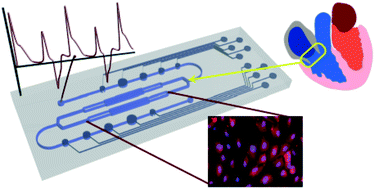Our official English website, www.x-mol.net, welcomes your feedback! (Note: you will need to create a separate account there.)
A microfluidic cardiac flow profile generator for studying the effect of shear stress on valvular endothelial cells†
Lab on a Chip ( IF 6.1 ) Pub Date : 2018-08-14 00:00:00 , DOI: 10.1039/c8lc00545a Joohyung Lee 1, 2, 3, 4 , Zachary Estlack 1, 2, 3, 4 , Himali Somaweera 1, 2, 3, 4 , Xinmei Wang 2, 3, 4, 5 , Carla M. R. Lacerda 2, 3, 4, 5 , Jungkyu Kim 1, 2, 3, 4
Lab on a Chip ( IF 6.1 ) Pub Date : 2018-08-14 00:00:00 , DOI: 10.1039/c8lc00545a Joohyung Lee 1, 2, 3, 4 , Zachary Estlack 1, 2, 3, 4 , Himali Somaweera 1, 2, 3, 4 , Xinmei Wang 2, 3, 4, 5 , Carla M. R. Lacerda 2, 3, 4, 5 , Jungkyu Kim 1, 2, 3, 4
Affiliation

|
To precisely investigate the mechanobiological responses of valvular endothelial cells, we developed a microfluidic flow profile generator using a pneumatically-actuated micropump consisting of microvalves of various sizes. By controlling the closing pressures and the actuation times of these microvalves, we modulated the magnitude and frequency of the shear stress to mimic mitral and aortic inflow profiles with frequencies in the range of 0.8–2 Hz and shear stresses up to 20 dyn cm−2. To demonstrate this flow profile generator, aortic inflow with an average of 5.9 dyn cm−2 shear stress at a frequency of 1.2 Hz with a Reynolds number of 2.75, a Womersley number of 0.27, and an oscillatory shear index (OSI) value of 0.2 was applied to porcine aortic valvular endothelial cells (PAVECs) for mechanobiological studies. The cell alignment, cell elongation, and alpha-smooth muscle actin (αSMA) expression of PAVECs under perfusion, steady flow, and aortic inflow conditions were analyzed to determine their shear-induced cell migration and trans-differentiation. In this morphological and immunocytochemical study, we found that the PAVECs elongated and aligned themselves perpendicular to the directions of the steady flow and the aortic inflow. In contrast, under perfusion with a fluidic shear stress of 0.47 dyn cm−2, the PAVECs elongated and aligned themselves parallel to the direction of flow. The PAVECs exposed to the aortic inflow upregulated their αSMA-protein expression to a greater degree than those exposed to perfusion and steady flow. By comparing these results to those of previous studies of pulsatile flow, we also found that the ratio of positive to negative shear stress plays an important role in determining PAVECs' trans-differentiation and adaptation to flow. This microfluidic cardiac flow profile generator will enable future valvular mechanobiological studies to determine the roles of magnitude and frequency of shear stresses.
中文翻译:

用于研究剪切应力对瓣膜内皮细胞的影响的微流体心脏血流发生器†
为了精确地研究瓣膜内皮细胞的力学生物学响应,我们开发了一种由气动微型泵组成的微流体流动轮廓发生器,该微型泵由各种尺寸的微型阀组成。通过控制这些微型阀的关闭压力和启动时间,我们调节了剪切应力的大小和频率,以模拟二尖瓣和主动脉的流入曲线,其频率范围为0.8–2 Hz,剪切应力最大为20 dyn cm -2。为了演示此流量剖面生成器,平均主动脉流入量为5.9 dyn cm -2以1.2 Hz的频率剪切应力,雷诺数为2.75,Womersley数为0.27,振荡剪切指数(OSI)值为0.2,用于猪主动脉瓣膜内皮细胞(PAVEC)进行机械生物学研究。分析了PAVEC在灌注,稳定血流和主动脉流入条件下的细胞排列,细胞伸长和α-平滑肌肌动蛋白(αSMA)表达,以确定其剪切诱导的细胞迁移和转分化。在这项形态学和免疫细胞化学研究中,我们发现PAVECs沿与稳定血流和主动脉血流方向垂直的方向拉长并对齐。相比之下,在流体剪切应力为0.47 dyn cm -2的情况下进行灌注,PAVEC会伸长并平行于流向对齐。与暴露于灌注和稳定血流的PAVEC相比,暴露于主动脉血流的PAVEC在更大程度上上调了其αSMA蛋白的表达。通过将这些结果与以前的脉动流研究进行比较,我们还发现正向剪切应力与负向剪切应力之比在确定PAVEC的反扩散和适应流量方面起着重要作用。这种微流体心脏血流分布发生器将使未来的瓣膜力学生物学研究能够确定切应力的大小和频率的作用。
更新日期:2018-08-14
中文翻译:

用于研究剪切应力对瓣膜内皮细胞的影响的微流体心脏血流发生器†
为了精确地研究瓣膜内皮细胞的力学生物学响应,我们开发了一种由气动微型泵组成的微流体流动轮廓发生器,该微型泵由各种尺寸的微型阀组成。通过控制这些微型阀的关闭压力和启动时间,我们调节了剪切应力的大小和频率,以模拟二尖瓣和主动脉的流入曲线,其频率范围为0.8–2 Hz,剪切应力最大为20 dyn cm -2。为了演示此流量剖面生成器,平均主动脉流入量为5.9 dyn cm -2以1.2 Hz的频率剪切应力,雷诺数为2.75,Womersley数为0.27,振荡剪切指数(OSI)值为0.2,用于猪主动脉瓣膜内皮细胞(PAVEC)进行机械生物学研究。分析了PAVEC在灌注,稳定血流和主动脉流入条件下的细胞排列,细胞伸长和α-平滑肌肌动蛋白(αSMA)表达,以确定其剪切诱导的细胞迁移和转分化。在这项形态学和免疫细胞化学研究中,我们发现PAVECs沿与稳定血流和主动脉血流方向垂直的方向拉长并对齐。相比之下,在流体剪切应力为0.47 dyn cm -2的情况下进行灌注,PAVEC会伸长并平行于流向对齐。与暴露于灌注和稳定血流的PAVEC相比,暴露于主动脉血流的PAVEC在更大程度上上调了其αSMA蛋白的表达。通过将这些结果与以前的脉动流研究进行比较,我们还发现正向剪切应力与负向剪切应力之比在确定PAVEC的反扩散和适应流量方面起着重要作用。这种微流体心脏血流分布发生器将使未来的瓣膜力学生物学研究能够确定切应力的大小和频率的作用。



























 京公网安备 11010802027423号
京公网安备 11010802027423号